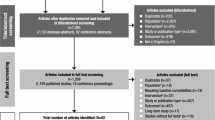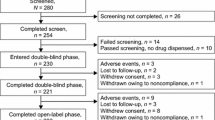Abstract
Clonidine, an α2-adrenergic agonist, is approved in the US as an extended-release (XR) tablet for the treatment of attention-deficit hyperactivity disorder (ADHD) in children and adolescents (aged 6–17 years).
In two, randomized, double-blind, multicenter, phase III trials of 8 weeks’ duration, clonidine XR improved the symptoms of ADHD in children and adolescents.
Significantly greater reductions from baseline in ADHD rating scale IV (ADHD-RS-IV) total scores at week 5 (primary endpoint) were achieved by recipients of clonidine XR 0.2 and 0.4 mg/day monotherapy than by recipients of placebo.
When added to patients’ normal stimulant regimen, significantly greater reductions from baseline in ADHD-RS-IV total scores at week 5 (primary endpoint) were achieved with a flexible dose of clonidine XR 0.1–0.4 mg/day than with placebo.
Symptomatic improvement of ADHD was achieved following 2 weeks’ treatment with clonidine XR. In both trials, significantly greater reductions from baseline in ADHD-RS-IV total scores were apparent at week 2 onwards for recipients of clonidine XR than for recipients of placebo.
Clonidine XR was generally well tolerated as monotherapy and as adjunctive therapy with stimulant regimens in clinical trials in children and adolescents.



Similar content being viewed by others
References
American Academy of Pediatrics. Clinical practice guideline: diagnosis and evaluation of the child with attention-deficit/hyperactivity disorder. Pediatrics 2000; 105(5): 1158–70
American Academy of Child and Adolescent Psychiatry. Practice parameter for the assessment and treatment of children and adolescents with attention-deficit/hyperactivity disorder. J Am Acad Child Adolesc Psychiatry 2007; 46(7): 894–921
Sallee FR. The role of alpha2-adrenergic agonists in attention-deficit/hyperactivity disorder. Postgrad Med 2010 Sep; 122(5): 78–87
Barbaresi WJ, Katusic SK, Colligan RC, et al. Long-term school outcomes for children with attention-deficit/hyperactivity disorder: a population-based perspective. J Dev Behav Pediatr 2007 Aug; 28(4): 265–73
American Academy of Pediatrics. Clinical practice guideline: treatment of the school-aged child with attention-deficit/hyperactivity disorder. Pediatrics 2001; 108(4): 1033–44
Wigal SB. Efficacy and safety limitations of attention-deficit hyperactivity disorder pharmacotherapy in children and adults. CNS Drugs 2009; 23Suppl. 1: 21–31
Graham J, Coghill D. Adverse effects of pharmacotherapies for attention-deficit hyperactivity disorder: epidemiology, prevention and management. CNS Drugs 2008; 22(3): 213–37
Molina BS, Flory K, Hinshaw SP, et al. Delinquent behavior and emerging substance use in the MTA at 36 months: prevalence, course, and treatment effects. J Am Acad Child Adolesc Psychiatry 2007 Aug; 46(8): 1028–40
The MTA Cooperative Group. National Institute of Mental Health Multimodal Treatment Study of ADHD follow-up: changes in effectiveness and growth after the end of treatment. Pediatrics 2004; 113(4): 762–9
Gonon F. The dopaminergic hypothesis of attention-deficit/hyperactivity disorder needs re-examining. Trends Neurosci 2009; 32(1): 2–8
Boehringer Ingelheim. Catapres® (clonidine hydrochloride, USP) tablets: prescribing information [online]. Available from URL: http://bidocs.boehringer-ingelheim.com/BIWebAccess/ViewServlet.ser?docBase=renetnt&folderpath=/Prescribing+Information/PIs/Catapres+Tabs/CatapresTabs.pdf [Accessed 2011 Jul 26]
Kurlan R. Treatment of ADHD in children with tics: a randomized controlled trial. Neurology 2002; 58(4): 527–36
Connor DF, Barkley RA, Davis HT. A pilot study of methylphenidate, clonidine, or the combination in ADHD comorbid with aggressive oppositional defiant or conduct disorder. Clin Pediatr (Phila) 2000 Jan; 39(1): 15–25
Hunt RD, Minderaa RB, Cohen DJ. Clonidine benefits children with attention deficit disorder and hyperactivity: report of a double-blind placebo-crossover therapeutic trial. J Am Acad Child Psychiatry 1985 Sep; 24(5): 617–29
Agarwal V, Sitholey P, Kumar S, et al. Double-blind, placebo-controlled trial of clonidine in hyperactive children with mental retardation. Ment Retard 2001 Aug; 39(4): 259–67
Hazell PL, Stuart JE. A randomized controlled trial of clonidine added to psychostimulant medication for hyperactive and aggressive children. J Am Acad Child Adolesc Psychiatry 2003; 42(8): 886–94
Nair V, Mahadevan S. Randomised controlled study-efficacy of clonidine versus carbamazepine in children with ADHD. J Trop Pediatr 2009 Apr; 55(2): 116–21
Palumbo DR, Sallee FR, Pelham WE Jr, et al. Clonidine for attention-deficit/hyperactivity disorder: I. Efficacy and tolerability outcomes. J Am Acad Child Adolesc Psychiatry 2008 Feb; 47(2): 180–8
Schvehla TJ, Mandoki MW, Sumner GS. Clonidine therapy for comorbid attention deficit hyperactivity disorder and conduct disorder: preliminary findings in a children’s inpatient unit. South Med J 1994 Jul; 87(7): 692–5
Daviss WB, Patel NC, Robb AS, et al. Clonidine for attention-deficit/hyperactivity disorder: II. ECG changes and adverse events analysis. J Am Acad Child Adolesc Psychiatry 2008 Feb; 47(2): 189–98
Keranen A, Nykanen S, Taskinen J. Pharmacokinetics and side-effects of clonidine. Eur J Clin Pharmacol 1978 May 17; 13(2): 97–101
Shionogi Pharma Inc. Kapvay (clonidine hydrochloride) extended-release tablets: prescribing information [online]. Available from URL: http://www.kapvay.com/Kapvay_final_09.28.10.pdf [Accessed 2011 May 25]
Jasper JR, Lesnick JD, Chang LK, et al. Ligand efficacy and potency at recombinant alpha2 adrenergic receptors: agonist-mediated. Biochem Pharmacol 1998 Apr 1; 55(7): 1035–43
Levy F. Pharmacological and therapeutic directions in ADHD: specificity in the PFC. Behav Brain Funct 2008; 4(12)
Cho SC, Kim JW, Kim BN, et al. Association between the alpha-2C-adrenergic receptor gene and attention deficit hyperactivity disorder in a Korean sample. Neurosci Lett 2008 Dec 3; 446(2–3): 108–11
Ernsberger P, Meeley M, Mann J, et al. Clonidine binds to imidazole binding sites as well as alpha 2-adrenoceptors in the ventrolateral medulla. Eur J Pharmacol 1997; 134(1): 1–13
Regunathan S, Evinger MJ, Meeley MP, et al. Effects of clonidine and other imidazole-receptor binding agents on second messenger systems and calcium influx in bovine adrenal chromaffin cells. Biochem Pharmacol 1991 Oct 24; 42(10): 2011–8
Reis DJ, Morrison S, Ruggiero DA. The C1 area of the brainstem in tonic and reflex control of blood pressure. State of the art lecture. Hypertension 1988 Feb; 11 (2 Pt 2): I8–3
Scahill L. Alpha-2 adrenergic agonists in children with inattention, hyperactivity and impulsiveness. CNS Drugs 2009; 23Suppl. 1: 43–9
Svensson TH, Bunney BS, Aghajanian GK. Inhibition of both noradrenergic and serotonergic neurons in brain by the alpha-adrenergic agonist clonidine. Brain Res 1975 Jul 11; 92(2): 291–306
Wang M, Ramos BP, Paspalas CD, et al. Alpha2A-adrenoceptors strengthen working memory networks by inhibiting cAMP-HCN channel signaling in prefrontal cortex. Cell 2007 Apr 20; 129(2): 397–410
Ji XH, Ji JZ, Zhang H, et al. Stimulation of alpha2-adrenoceptors suppresses excitatory synaptic transmission in the medial prefrontal cortex of rat. Neuropsychopharmacology 2008 Aug; 33(9): 2263–71
Buzsaki G, Kennedy B, Solt V, et al. Noradrenergic control of thalamic oscillation: the role of alpha-2 receptors. Eur J Neuro 1991; 3(3): 222–9
Berridge CW, Foote SL. Effects of locus coeruleus activation on electro-encephalographic activity in neocortex and hippocampus. J Neurosci 1991 Oct; 11(10): 3135–45
Coull J, Nobre A, Frith C. The noradrenergic alpha2 agonist clonidine modulates behavioural and neuroanatomical correlates of human attentional orienteering and alerting. Cereb Cortex 2001; 11(1): 73–84
Jain R, Segal S, Kollins SH, et al. Clonidine extended-release tablets for pediatric patients with attention-deficit/hyperactivity disorder. J Am Acad Child Adolesc Psychiatry 2011 Feb; 50(2): 171–9
Kollins SH, Jain R, Brams M, et al. Clonidine extended-release tablets as addon therapy to psychostimulants in children and adolescents with ADHD. Pediatrics 2011 Jun; 127(6): e1406–13
DuPaul C, Power T, Anastopoulos AD, et al. ADHD Rating Scale-IV: checklists, norms, and clinical interpretation. New York: Guilford Press, 1998
Acknowledgments and Disclosures
This manuscript was reviewed by: K. McBurnett, Department of Psychiatry, University of California, San Francisco, CA, USA; P.J. Santosh, Department of Child and Adolescent Mental Health, Great Ormond Street Hospital, London, UK.
The preparation of this review was not supported by any external funding. During the peer review process, the manufacturer of the agent under review was offered an opportunity to comment on this article. Changes resulting from comments received were made by the author on the basis of scientific and editorial merit.
Author information
Authors and Affiliations
Corresponding author
Rights and permissions
About this article
Cite this article
Croxtall, J.D. Clonidine Extended-Release. Pediatr-Drugs 13, 329–336 (2011). https://doi.org/10.2165/11208100-000000000-00000
Published:
Issue Date:
DOI: https://doi.org/10.2165/11208100-000000000-00000




